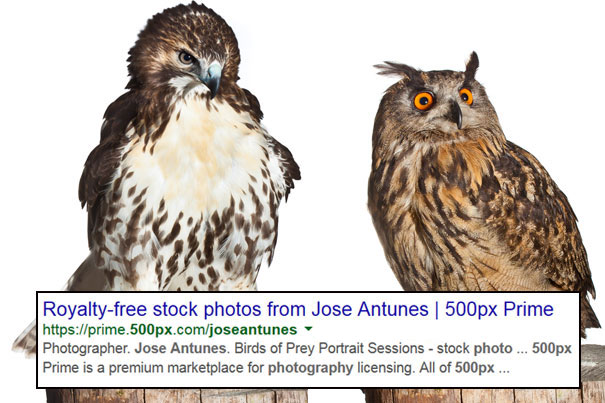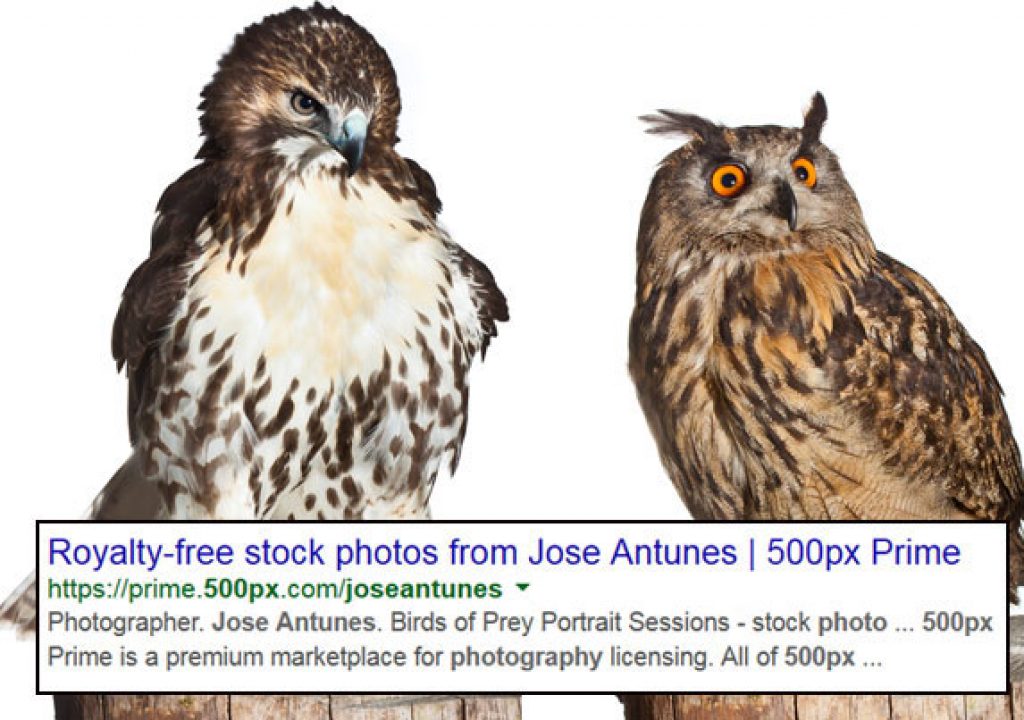
When I recently browsed the web to show some images to a friend, I found a Google entry under “royalty-free stock photos from Jose Antunes | 500px Prime”. I never gave 500px permission to market my photos for me, so I had to investigate…
Let’s put things right from the start. I do not sell images, through agencies, under any other licence than Rights-Managed. I’ve done so since my days with the FPG – New York, back in the eighties, through, more recently, Alamy. So I was absolutely stunned to find that my images were placed for sale at 500px Prime as “royalty-free stock”.
The first thing I did was to delete all my images from the site, although I kept the account, as proof that I had it. I do not remember exactly when I created an account with 500px – and not 500px Prime, which is the merchant arm of the website – I know I created it to showcase a set of 12 photos from a series entitled “Birds of Prey Portrait Sessions”.
Birds of Prey Portrait Sessions is a series of photographs I created in 2011, in a studio-like setting, of hawks and owls. The birds were photographed in what can be called a Meet Your Neighbours-style, with completely white backgrounds, obtained through the use of flash behind a translucent diffuser, and a second flash in front. Meet Your Neighbours is an international project about photography of flora and fauna close to home, created to raise awareness of those “neighbours” so many times forgotten.
The search in Google showed me that besides my normal 500px account I had one at their Prime website, for selling photos in a way I never imagined I would do
Let’s go back to 500px Prime. As far as I remember, the idea of having a small portfolio online with the birds, at a specific location, seemed interesting, and 500px was around, so I must have created a space there, loaded the images, linked to them and forgot all about it. I do not spend much time visiting those websites, although I usually place a few photos here and there, to test systems, so as a writer I know what I am writing about, when I comment on photo-sharing networks used by people to get their photos published.
The web is a fantastic tool, but it always has two sides, and one of them was just revealed to me. Somewhere in 2014, it seems, 500px decided to create their tool to sell photographs, and so the 500px Prime started. And from what I discover now, it started the wrong way, with the photographers getting a 30% commission of the wholesale of their images.
Royalty-Free Without Asking
Well, it obviously made some— many — people angry, so rapidly 500px Prime turned things upside down, giving photographers 70%. Put this way it sounds interesting, and for many — especially those that do not do their accountancy – it seemed right. But 70% of $250 is $175, meaning that’s all you get for one image sold Royalty-Free. Meaning you’re selling it for life, and for buyers to use it in whichever way they want. Yes, unlimited print and digital impressions forever. Is this the way you want to sell your photographs and make a living?
I don’t. And I did not give 500px Prime any permission to include my photos in their scheme. So I simply deleted them, and I sincerely hope that my photos do not show up anywhere in their site. Things have gone horribly wrong with the microstock business, and contrary to what some believe, examples like the one from 500px do nothing to make things better, in my opinion.
SmugSmug offers a solution for those who want to sell their photos online and control the pricing structure
I’ve not looked around to check if this is a regular practice, but from the experience with 500px Prime I would say there are probably more situations like this. While it is true that for some it will sound like a good idea, the acceptance of situations like this and many others has devaluated photography and the profession.
I’ve no doubt that many of these websites for sharing photographs are a good way to show your photographs and promote your photography, whether you pay a subscription or use them freely, but do check regularly if anything changed and if, as it happened to me, your images are not being presented as something you didn’t sign for.
Professsional Solutions
If you’re looking for a place to sell your photographs through, there are multiple options available. The last decade saw many photographers moving away from traditional agencies to create their own stock image archives, as a way to better control the sales of their own work. While this may not be a solution for everybody, there are other viable solutions you can explore. SmugSmug, for example, has plans that include the sale of not only photographs but also video. And many other spaces online provide similar solutions.
PhotoShelter allows photographers, even those with free accounts, to have a gallery with a shopping cart and define their prices and licensing options. PhotoShelter charges 30% on sales made through their website
One space people should visit is PhotoShelter. PhotoShelter hosts more than 200 million images from over 80,000 professional photographers. The company started in 2005, as a place to host photographs and, at the time, a stock image agency. The original stock image concept was dropped, but PhotoShelter grew, while others vanished, to become a reference in the market for many photographers.
Although I only have a free account with them, I know PhotoShelter from when it started as a stock image agency — I had my images there at the time — and I have kept a page with them as a reminder of those days. Even with a free account you can have your own shopping cart and sell photographs, defining the exact price profile for each type of product licensed. Users can choose the way to sell their images:
- Prints
- Products
- Packages
- Personal-Use Licenses
- Royalty-Free Licenses
- Rights-Managed Licenses
According to the options chosen the system allows you to create your own pricing profiles, but offers you a general pricing profile for Rights-Managed images, which uses a rights-managed pricing calculator powered by Cradoc fotoSoftware’s fotoQuote application. That’s what I use and I consider it to be a fair choice, as it follows the general pricing for the stock image market, or at least the one I think is right. PhotoShelter takes 30% of the sale price, but the prices are more in line with what photographers should expect to get paid for their work. You can visit my own page, or any other author’s page in PhotoShelter — with a shopping cart — and try it yourself.
The price calculator for Rights-Managed photos at PhotoShelter is a good tool to use to check fair prices for the use of photographs in different industries
PhotoShelter is also interesting because it works as a hub for a lot of activities related to freelancing. From free eBooks published about multiple aspects of the business to its offer of Lattice boards for authors to showcase their work under a controlled layout, PhotoShelter remains a place to visit and promote. It still does not offer space for video, but it is in their roadmap. Give it a try and you’ll be hooked!
Whatever you do, take care of your photographs or videos, if you share them online. It is good to share those experiences with others, but keep checking how they are used. After all, you’ve invested many hours and cash on the work you’re sharing and you expect to be paid accordingly for your efforts. Don’t let others dictate the way you sell your work!

